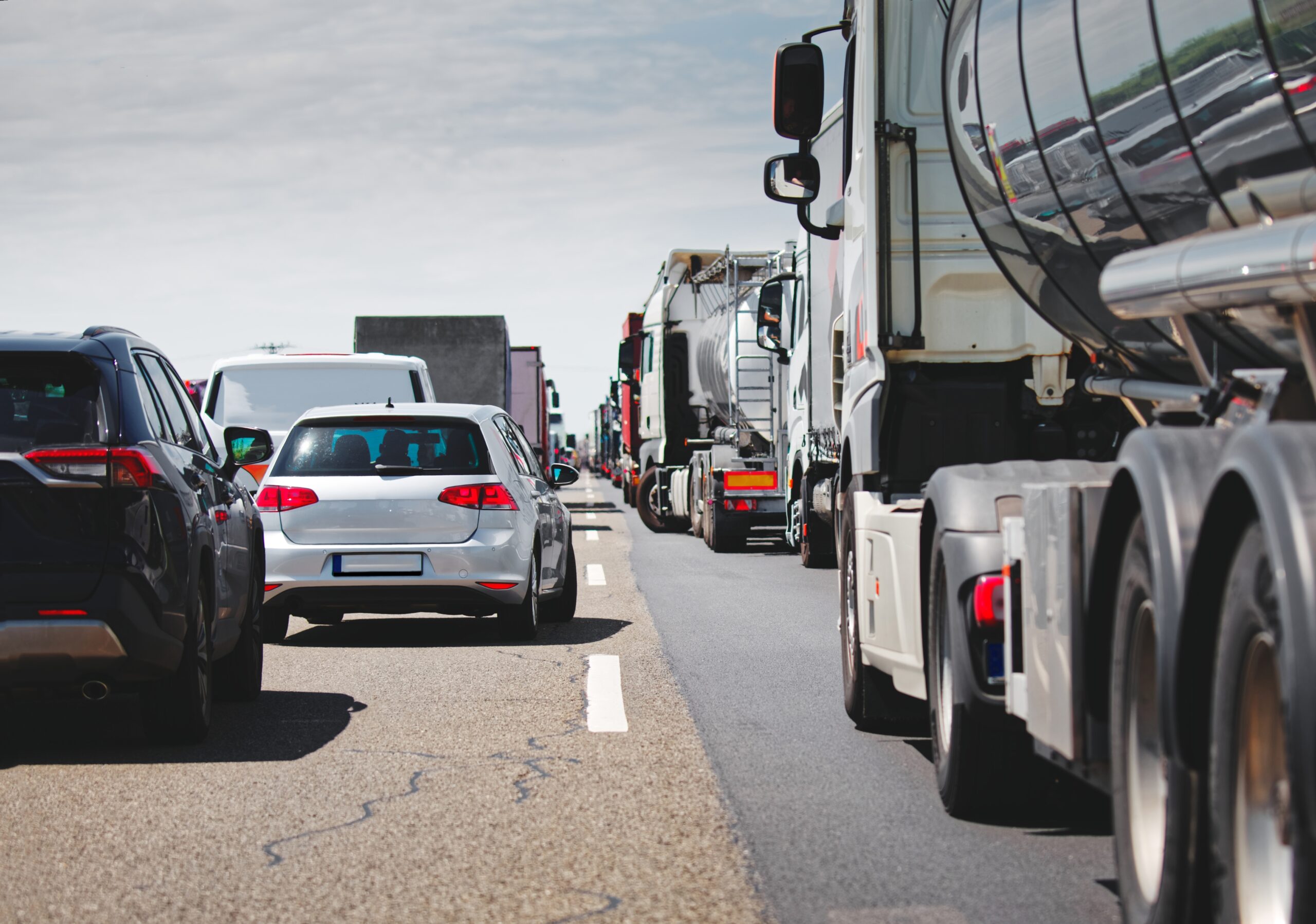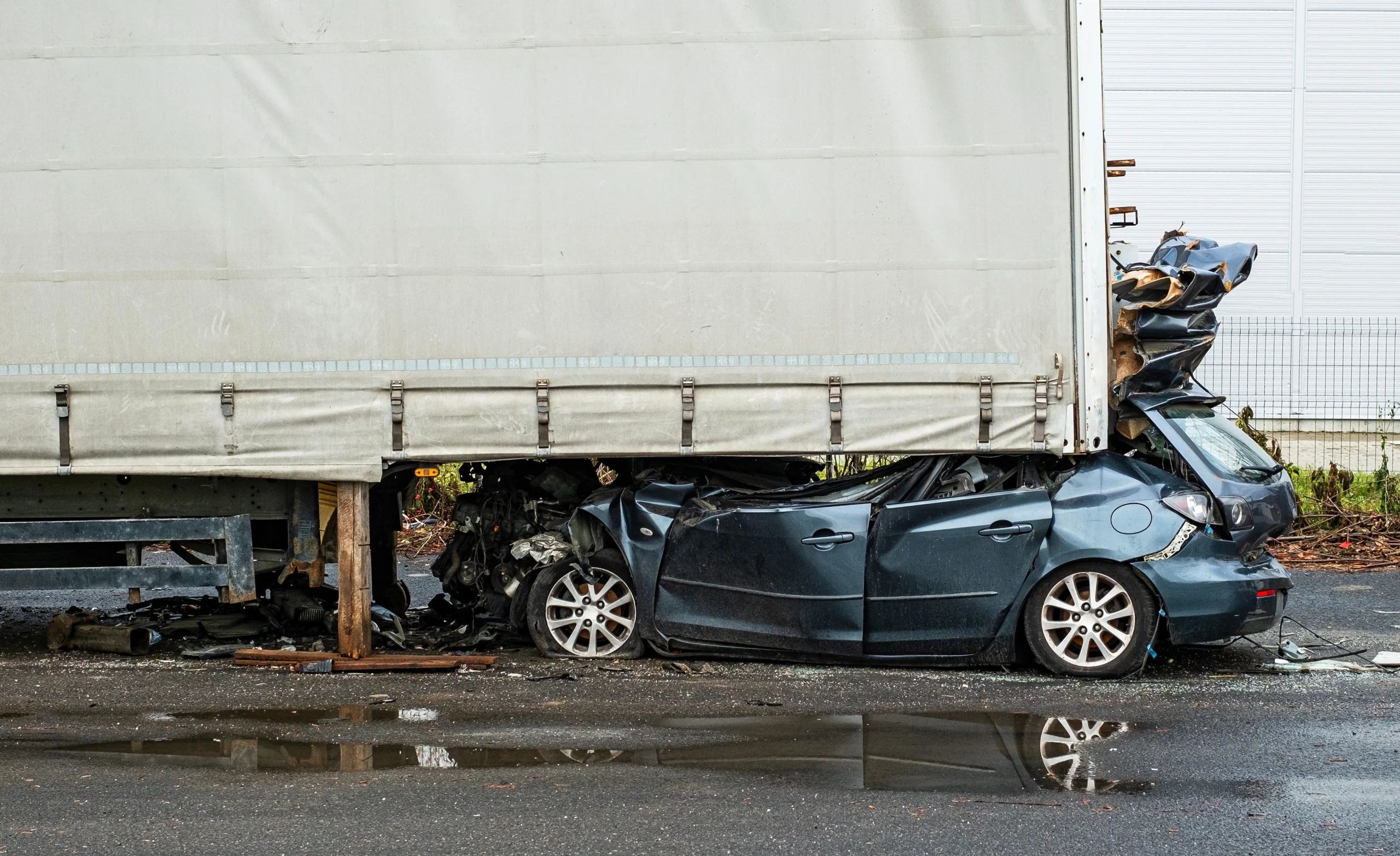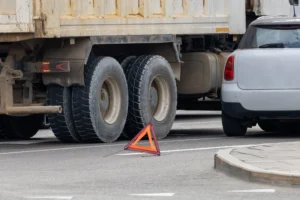
- Holzman & Dickriede Attorneys at Law, LLC
- |
Baltimore moves freight. From Seagirt and Dundalk to Sparrows Point, drayage trucks, flatbeds, car carriers, and tankers fan out across I-95, I-895, I-695, I-83, and the city’s industrial corridors every hour of the day.
That volume, plus tight urban geometry, complex detours since the Francis Scott Key Bridge collapse, and strict tunnel restrictions, creates a unique risk profile for serious truck crashes.
If you or a loved one were hurt in a Baltimore truck collision, Holzman & Dickriede Attorneys at Law can explain what went wrong, hold the right parties accountable, and pursue full compensation.
Why Baltimore Sees Distinctive Truck Crash Patterns
The Port of Baltimore is America’s top roll-on/roll-off gateway for autos and heavy equipment, feeding heavy drayage flows along Broening Highway, Keith Avenue, Holabird Avenue, and O’Donnell Street. That mix of long-haul tractors and short-haul drayage in dense city traffic increases conflicts at merges, off-ramps, and signalized intersections. 
The Key Bridge collapse pushed even more trucks onto the remaining crossings and beltway segments, and hazardous-materials restrictions through the Fort McHenry and Harbor tunnels force long detours. These stressors can magnify fatigue, speeding, and route-finding errors.
The Most Common Causes We See—and How They Play Out in Baltimore
1) Driver Fatigue and Hours-of-Service Pressure
Fatigue degrades reaction time and lane-keeping, and port surges, overnight gate hours, and weather-delayed schedules amplify it. Federal hours-of-service (HOS) rules cap most property-carrying CMV drivers at 11 hours of driving in a 14-hour window, require a 30-minute break after eight consecutive hours of driving, and impose 60/70-hour weekly limits.
When dispatchers or drivers ignore those limits—or when detention at a terminal eats into a driver’s day—risk climbs quickly. We utilize electronic logging device (ELD) data, gate timestamps, and GPS breadcrumbs to verify the accuracy of hours, breaks, and speed.
2) Distraction Behind the Wheel
Phone use, in-cab tablets, and navigation fiddling contribute to late braking in stop-and-go traffic and missed hazard recognition. In Baltimore, this often occurs at approaching bottlenecks, such as the Fort McHenry Tunnel toll plaza, the I-95/I-395 split, or downtown one-way streets near the Convention Center.
We subpoena carrier cellphone records and in-cab telematics, and we cross-check them against traffic camera time stamps.
3) Speed too Fast for Conditions and Following too Closely
Heavy trucks need long stopping distances. On wet bricks, steel-deck drawbridges, or polished urban asphalt, braking distance expands dramatically.
We regularly see rear-end impacts on elevated ramps, queue jumps near port gates, and “start-stop” chain collisions on I-95. Automated enforcement and CCTV help nail down approach speeds, signal phases, and time-distance relationships; Baltimore’s ATVES camera network and the CitiWatch camera partnership frequently supply the angle that the crash report missed.
4) Improper Lane Changes and Blind-Spot Conflicts
Large trucks have extensive “no-zones” at the passenger-side quarter, rear, and immediately in front of the cab. On multi-lane segments of the JFX (I-83) and I-95, sudden lane changes or merges without a full mirror scan can clip a smaller vehicle, especially when a Jersey barrier or work-zone cone line offsets the truck.
We analyze scrape and transfer marks, mirror position, dashcam footage, and the vehicle’s yaw path to reconstruct how and why a sideswipe turned into a secondary spin or rollover.
5) Wide Turns and Off-Tracking at Tight City Corners
Baltimore’s rowhouse blocks and short curb radii invite trailer off-tracking, curb strikes, and pedestrian conflicts. Common triggers include right turns from too-far-inside lanes on Fleet, Eastern, or Fayette and left turns that “buttonhook” into oncoming lanes in Highlandtown and Federal Hill.
We map trailer sweep using surveillance video and scene measurements, then compare it to CDL handbook standards and carrier training materials to establish preventability.
6) Unsecured or Shifting Cargo
Cargo securement failures cause tip-overs, lane intrusions, and flying debris incidents. Federal rules in 49 CFR Part 393 Subpart I set the minimum tiedown strength, number of tiedowns, and commodity-specific standards. Baltimore handles a wide range of materials, including steel, machinery, lumber, and autos—all with different securement requirements.
When loads aren’t blocked/bridged or tied down to the required working load limit, a panic steer or hard brake can turn a save into a disaster. We inspect tie-downs, winches, anchor points, and deck friction, and we match photos to the securement tables to show exactly what failed.
7) Poor Vehicle Maintenance: Brakes, Tires, and Lights
Brake imbalance, out-of-adjustment chambers, thin pads, and air leaks are perennial culprits; so are worn tires and inoperative lights. Annual roadside blitz data consistently show brake system defects as a top reason trucks are placed out of service.
We obtain inspection histories, maintenance work orders, and telematics fault codes, then compare them with post-crash measurements to prove a carrier skipped required maintenance or ignored alerts.
8) Overweight or Oversized Moves on the Wrong Route
Maryland imposes strict size and weight limits; oversize or overweight loads require MDOT SHA permits and designated routes. Cutting through residential streets or attempting tunnel approaches with over-height or over-width vehicles is dangerous and illegal.
We verify permits, route surveys, and escort logs; if a carrier took a shortcut and collided with infrastructure or caused a secondary crash, the paper trail shows it.
9) Hazardous-Materials Routing and Tunnel Restrictions
Hazmat loads are flatly prohibited in Baltimore’s Harbor (I-895) and Fort McHenry (I-95) tunnels. Since the Key Bridge collapse, compliant carriers have faced long beltway detours. At the same time, noncompliant operators have tried to sneak prohibited cargoes through the tunnels—creating explosive risk in confined spaces and heavy traffic.
Those routing errors are both dangerous and legally significant. We secure weigh-station data, MDTA citations, and dashcam/toll imagery to prove the route chosen and why it violated safety rules.
10) Work-Zone Speed and Lane-Control Violations
Long-term resurfacing, utility work, and bridge projects squeeze lanes, flatten merge angles, and shift patterns—prime conditions for side-swipes and underrides. Maryland’s Road Worker Protection Act now imposes harsher automated work-zone penalties, changing driver behavior and evidentiary options (camera timing, signage compliance, and speed verification).
We harvest work-zone plans, device logs, and camera records to stitch together the minute-by-minute story.
11) Weather, Lighting, and Visibility
Fog off the harbor, heavy summer downpours, and winter black ice on Northern Parkway or Perring Parkway compound risks, especially when mixed with night glare and missing or faded lane markings.
We correlate weather station data, dashcam exposure, and roadway friction with speed profiles to show what a reasonably careful professional should have done.
12) Pedestrian and Cyclist Conflicts
Urban freight means frequent right turns across bike lanes and crosswalks. Mirror placement, A-pillar size, and cab height all affect right-turn visibility. We examine line-of-sight diagrams and “swept path” models to demonstrate how a safe turn should have been executed with a proper slow-roll, mirror check, and horn.
Baltimore’s Evidence Advantage—if You Act Fast
Public and private cameras cover side streets and arterials in Baltimore. The city’s Automated Traffic Violation Enforcement System (ATVES) operates 24/7, conducting red-light and extensive speed enforcement. Additionally, the CitiWatch Community Partnership maintains a registry of privately owned cameras, which can be crucial following a crash.
Add port gate cameras, warehouse lots, parking facilities, MTA buses, and business CCTV, and there’s a good chance the moments before impact were captured from multiple angles. We send preservation letters immediately, canvas the corridor, and line up video with Event Data Recorder (EDR) downloads, crash-scanner measurements, and telematics to build a time-stamped narrative of precisely what happened.
Who May Be Responsible in a Baltimore Truck Crash
Liability in a Baltimore truck crash is often shared. Depending on the facts and Maryland law, potential defendants can include:
- Motor carrier (trucking company): Negligent operation policies; unsafe hiring, retention, training, or supervision; dispatch pressure; and maintenance failures.
- Truck driver: Violations of traffic laws and CDL/FMCSR rules.
- Shipper/loader: Negligent cargo securement or improper weight distribution.
- Broker: Negligent selection of a carrier, where the facts support it.
- Maintenance contractor or dealer: Faulty inspections, servicing, or repairs.
- Public entity (limited circumstances): Dangerous road design, signage, or signal timing—subject to strict notice requirements and governmental immunity rules.
- Alcohol-related actors: Maryland generally bars dram-shop claims against vendors for serving adults, but social-host liability can arise for knowingly enabling under-21 drinking.
We pursue every viable defendant and every coverage layer—including motor-carrier liability, MCS-90 implications, shipper/loader coverage, and UM/UIM options where needed—to maximize recovery under Maryland law.
How We Prove the Cause and Value of Your Case
We build cases with hard evidence and trusted experts—turning complex trucking data and medical proof into a clear, compelling story for settlement or trial.
- What we collect (liability & causation): Police ACRS reports; 911 audio; dispatch CAD; officer body-worn camera; EDR “black box” downloads; ELDs and Qualcomm/telematics; maintenance logs; driver-qualification and training records; drug/alcohol compliance; and carrier safety policies.
- Experts we bring in: Crash reconstructionists, human-factors specialists, brake and tire engineers, and cargo-securement experts—so technical failures are explained in plain English.
- How we prove damages: Coordination with treating physicians and specialists; life-care plans when needed; wage-loss and diminished earning-capacity analyses with vocational/economic experts; and day-in-the-life documentation to show how the crash changed your everyday reality.
From data pulls to expert testimony, we connect every dot—cause, fault, and full damages—so the value of your claim is proven, not merely argued.
Maryland rules that can affect your recovery
Maryland follows contributory negligence. If a plaintiff is found even 1% at fault, recovery can be barred. That’s why early, thorough evidence gathering matters so much here—especially in lane-position, speed, and “sudden emergency” disputes.
We prepare cases to overcome defense narratives with hard data, camera time stamps, and expert analysis.
What to do after a Baltimore Truck Crash
Your priorities are safety, medical care, and preserving evidence. These steps help protect your health and your claim.
- Get help & get safe: Call 911, ask for police and medical response, and move to a safe spot away from live lanes.
- Photograph the scene (only if safe): Vehicle positions, skid/yaw marks, debris fields, signal heads, and lane markings.
- Document the truck: Trailer placards, USDOT numbers, conspicuity tape, and close-ups of cargo securement, tire condition, brake smoke, and any leaks.
- Find witnesses & cameras: Collect names and contact info for eyewitnesses and note nearby businesses with exterior cameras.
- Seek prompt medical care: Get evaluated immediately—even if symptoms seem manageable—since soft-tissue and brain injuries often appear later.
- Control communications: Decline any recorded statements to insurers until you’ve spoken with counsel.
- Protect your privacy: Avoid signing blanket medical releases that allow carriers to access your entire medical history.
- Track your losses: Keep all receipts and log missed work and limits on everyday activities.
By staying safe, getting checked out, and locking down evidence, you strengthen your case from day one—then let experienced counsel handle the insurers and the heavy lifting.
Answers to Common Questions
How do you prove a trucker was too tired to drive?
We pull ELD logs, dispatch messages, fuel and toll receipts, gate entries, and even meal deliveries to reconstruct the duty cycle. If a driver exceeded the 11/14/60/70 HOS rules or skipped the 30-minute break after 8 hours, we’ll find it and explain it.
What if the truck’s brakes or tires were bad?
We compare post-crash measurements to inspection histories and the carrier’s maintenance BASIC performance. Roadcheck data show brake defects are consistently a leading out-of-service trigger; that pattern helps juries understand why neglected maintenance is so dangerous.
Can we get video in Baltimore?
Often, yes. We request ATVES footage, canvass CitiWatch-registered cameras and nearby private systems, and align those feeds with 911 timestamps, EDR data, and vehicle speed traces.
Is a hazmat detour violation relevant to my case?
Absolutely. MDTA and SHA make it clear: many hazmat commodities are forbidden in the tunnels. In the post-Key Bridge environment, route compliance is under a microscope; violating those rules can support negligence per se and punitive-conduct arguments in egregious cases.
Do truck crashes cause outsized harm?
Unfortunately, yes. National data show thousands of people die each year in crashes involving large trucks, and Baltimore’s mix of passenger traffic, port drayage, and constrained corridors increases exposure. We use national datasets sparingly—anchoring your case in local, case-specific evidence, but they help explain why careful compliance matters.
How Holzman & Dickriede Build Leverage for Baltimore Truck Cases
We turn time-sensitive evidence and trucking knowledge into negotiating power, positioning your case to settle strong or try well.
- Immediate preservation: We fire off spoliation/hold letters to carriers, tow yards, and terminal operators to lock down tractors, trailers, EDR data, onboard cameras, and maintenance records before anything “goes missing.”
- Technical mastery: We know the CDL standards, Hours-of-Service rules, cargo-securement tables, and tunnel restrictions, and translate them into plain-English violations that resonate with adjusters and juries.
- Local knowledge: We understand port gates, common dray routes, expected queue patterns, and where cameras typically capture key angles around Baltimore.
- Litigation-first posture: From day one, we build as if the case will be tried. That discipline pressures insurers, improves settlement value, and ensures we’re trial-ready when that’s the best path.
- Contingency fees: You owe no attorney’s fee unless we recover money for you.
Every move is designed to preserve proof, control the narrative, and maximize your recovery.
Ready to Talk?
If a truck crash in Baltimore has upended your life, you don’t have to navigate liability fights, medical bills, and insurance tactics on your own. Contact Holzman & Dickriede Attorneys at Law for a free, no-obligation case review.
We’ll listen, move fast to preserve the proper evidence, from ATVES and CitiWatch video to EDR and maintenance logs, and build a plan to protect your case, your time, and your future.


